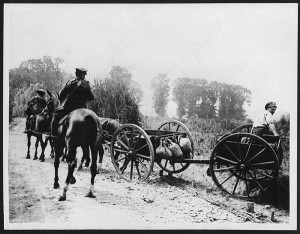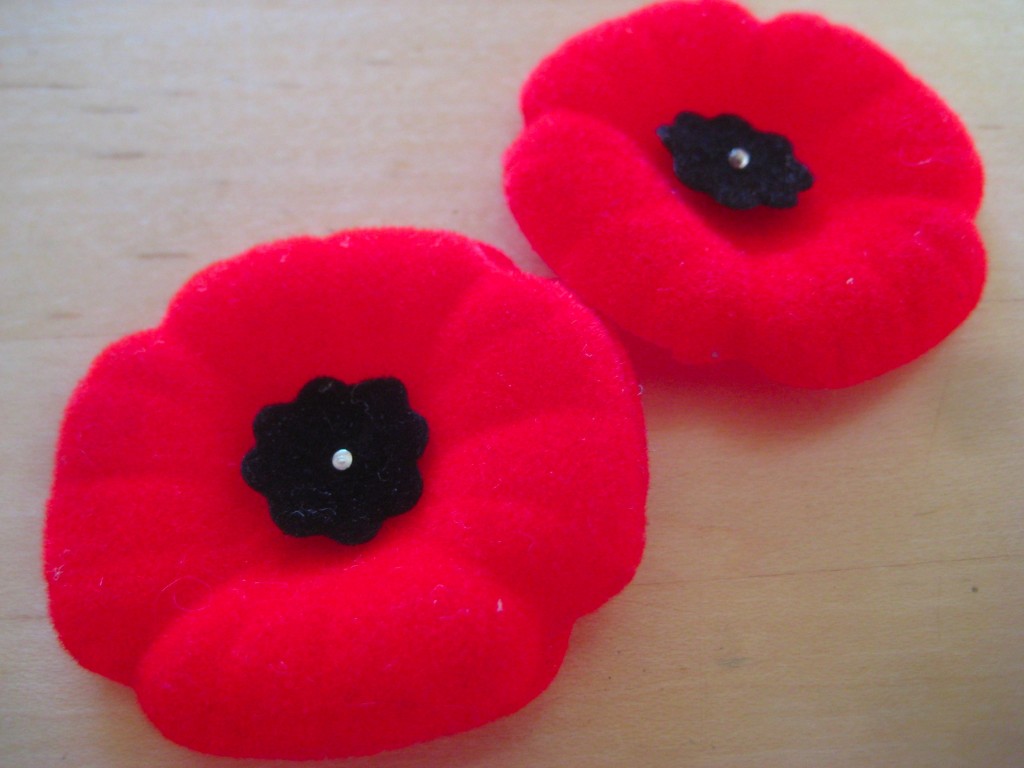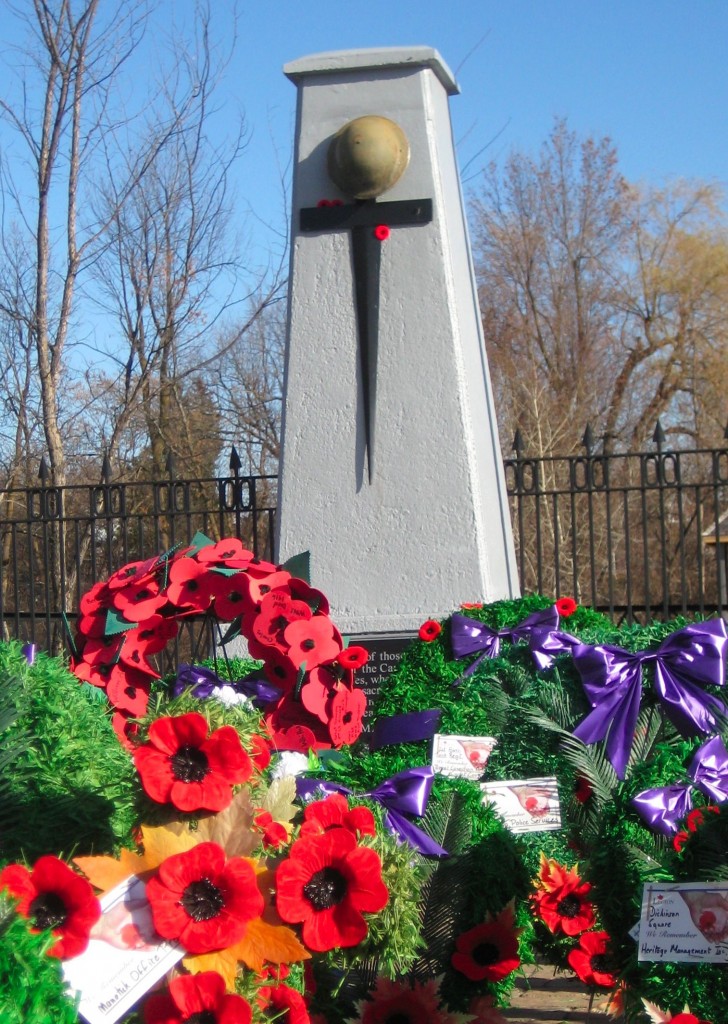Pondering the poppy
With November 11 looming over the first third of this month, it’s been poppy time where I live once more.
Having spent the majority of my life in the U.S. I can contemplate this quaint Canadian custom with an anthropologist’s detachment. But, I must confess, I also feel the power of its symbolism.
If I remember correctly, one might sometimes see poppies in the U.S. around this time of year. In Hawaii at least, in decades past, my foggy memory is of fairly small papper poppies on a twist wire. Limited distribution was very hit & miss. And wearing a poppy was a whim, not an expected mark of civic respectability.
In contrast, many Commonwealth countries make a near fetish of wearing the poppy – especially public servants and politicians.
Talking to friends who work in TV here I am told that whole baskets of poppies are kept on hand, to ensure all on-air personnel and any guests are appropriately emblazoned. This is not unlike the extra-legal requirement that U.S. politicians wear a flag lapel pin, or how presidents close major speeches with “God bless the United States of America”. (Least they suffer the consequences for failing to do so.)
According to this 2011 BBC article “Who, What, Why: Which countries wear poppies?” the main participants are the UK, Canada, Australia, New Zealand and South Africa.
In Canada, the black and red plastic cut-outs are offered for a voluntary donation at countless check-out counters, reception desks or kiosks staffed by young cadets or elderly legionaries. Proceeds go to something called the Poppy Campaign (a national program) or Poppy Funds earmarked for local distribution, such as this one in Edmonton, Alberta.
Here’s language from the national fund for how the millions in coins and bills gets spent:
The primary purpose of the Poppy Trust Fund is to provide financial assistance to veterans in need, and to their dependants. In accordance with the General By-laws of The Royal Canadian Legion, the need may be for shelter, food, fuel, clothing, prescription medicine or necessary transportation. Comforts for veterans and their surviving spouses who are hospitalized and in need may also be provided. These comforts are defined as confectioneries, reading material, flowers, personal toiletry articles, and other items of a similar nature.
The poppy in Canada comes on a simple stick pin, and the blasted things ALWAYS fall off. Cynics suspect this is intentional, to ensure repeat donations.
The great mystery to me is: where do they all go? I can count on one hand the number of poppies I’ve found underfoot, despite having lost many myself and hearing from others of near-daily losses. (Maybe people pick them up quickly, out of respect for the image – or fear of stepping on the pin??)
My own default personality is that of a non-compliant individualist. Yet I wear the poppy. Why?
Two reasons. Firstly, the poppy is forever linked to the horrors of World War I (1914-1918).
WWI carries extra resonance in Canada for a couple of reasons. This country is sometimes said to have come of age in that war, because of its heroic achievement at Vimy Ridge. Also, the haunting, iconic poem which established the humble red poppy as the symbol of WW I (“In Flanders Field“) was penned by Canadian poet and army doctor, Lt. Col. John McCrae.
My maternal grandfather, Harold St. John, was in that one. A 10th-generation Yankee and a trained botanist, he ended up with the 4th machine gun platoon, 309th Battalion in the 78th Division. (My military lingo may be off, but that’s the gist of it.)

“A team of horses or mules is pulling an empty limber along a dust track” Official British photo probably taken by John Warwick Brooke (National Library of Scotland)
The U.S. was the last major power to enter what was initially called the Great War, officially participating from April 1917 to Nov 1918. But war and combat are pretty real for all participants. The 78th division fought across France during the war’s closing months.
Grandfather was selective in recalling those experiences. He spent a just few weeks as a sergeant in the trench warfare typically associated with that war. He ended up as a 2nd Lt. who spent months criss-crossing France by train, wagon or foot in a jumble of training and fighting.
He preferred safe topics, such as the challenges presented by the (supposedly) all-terrain cargo vehicle of that time, something called the limber. And how horses were far easier to manage than Missouri mules!
It wasn’t all bad. Grandfather spoke fluent French which made him point person for all manner of interactions with local residents while traveling or billeting the men and animals. He admired the inhabitants and valued those memories. At war’s end he was even able to spend a few months studying plant specimens at the Muséum national d’Histoire naturelle in Paris.
Grandfather told funny stories about ways soliders would lighten their kits, or endure silly regulations. In later years his eyes would mist remembering the time his platoon got back to “civilization” after a month without lights, music or safety.
I still have a scrap of paper he’d saved, a list scribbled off in pencil of those killed and wounded after – what? A battle? A skirmish? Artillery bombardment? He didn’t want to dwell on that.
For many years after the war grandfather wore his wide-brimmed felt army hat on hikes he lead as a botany professor. His WW I sleeping bag was stashed in the attic of his Honolulu retirement cottage. I agonized about its fate as we packed up to move to Ontario. The local army museum didn’t want it. My relatives all said no thanks. With the greatest reluctance, I sent it to the trash. (I know, I know! That seems wrong. But it was ratty and would never survive a wash.) One can’t keep everything and stay sane.
I did keep his hat.
For me then, the poppy is a tribute to a fine, responsible man who chose to answer his country’s call because that seemed proper to him. A way to honor others who did the same – in wars they neither asked for, nor shirked.
The second reason I wear the poppy is because I feel bad how much is asked of those who serve and how little is provided in return. Does wearing a poppy redress that shoddy record? I would argue it’s barely even a start.
On the flip side, it’s also an unfortunate reality that symbolic gestures (like wearing a poppy) can glorify war or be manipulated in unwholesome ways. To paraphrase Samuel Johnson, patriotism can be “the last refuge of a scoundrel.” Forced conformity rings hollow as well.
With that in mind, if anyone choses to not wear a poppy, or likes the counter-part white poppy (symbolizing pacifism) those positions have my respect too.
In the poppy-as-pop-art hierarchy, UK versions seem snazzier than the ones used in Canada.
UK poppies have black, red and green, thanks to the addition of a leaf element. Big wigs and royalty have even better poppies – more like artificial flowers than cheap cut-outs.
Some poppies are still hand-made, usually as part of programs that employ disabled vets or workers. Here’s a striking audio/slide show from the BBC on making those poppies, some 500,000 of the 45 million used in the UK this year.
If you can get a hold of needle-nose pliers, there’s an easy solution to the lost poppy problem of the Canadian version.
Snip the bottom third off the straight pin. bend the remaining pin into a circle and attach a safety pin.
Many get a small flag pin and use that as a center anchor too.
As we salute the dead and think more on what we owe our living service men and women, here’s to what Remembrance Day and Veteran’s Day mean – or should mean.
If only ‘how to end war’ was as easy as how to keep a poppy pin on, eh?
Tags: canada, history, Poppy pin, Remembrance Day, Veterans Day, WWI











A beautiful essay on a war that still resonates, though evermore dimly. The poppy occupies a prominent spot at the threshold of the modern age: As much a memorial to earlier ideals of conflict, destroyed by new forms of industrialized warfare, as a memorial to the soon-to-be outmoded form of popular communication that delivered the symbol to the western public’s imagination: the poem.
As for McCrea’s exhortation to carry on the torch of warfare, Yeats’s (An Irishman Foresees His Death) or Owens (Anthem for a Doomed Youth) seem to capture the historical moment better.
Wonderful piece, Lucy. A few years ago, the history of WWI captured my interest and I read both fiction and non-fiction about the era. From Canada, I’d highly recommend Jane Urquhart’s “The Stone Carvers.”
Marquil and Ellen, thanks for your thoughtful comments.
I agree that McCrea’s poem has a potentially discordant section.
But I think those troublesome lines are misunderstood by many today.
The poem works beautifully for me, at least, if it is re-cast as a cry that the cause must rise above squabbles of imperialist powers.
Many in the Great War thought (hoped) the incredible slaughter could be in the service of something that might justify the madness.
Since WW I seems to have solved nothing – and arguable caused WW II – we tend to roll our eyes at the phrase “war to end all war”.
But that was one way WW I was “sold”.
A tempting prospect, that.
One last harrowing, nightmare to be sure there would be no more.
H.G. Wells penned a number of articles that became a WW I-era book to that effect.
When John McCrae wrote this:
Take up our quarrel with the foe:
To you from failing hands we throw
The torch; be yours to hold it high.
If ye break faith with us who die
We shall not sleep, though poppies grow
In Flanders fields.
I postulate that the forces that create war are the foe McCrae wanted defeated,least the numbing waste be for naught.
I’ll quote a section from the aforementioned Wells book found on an
Internet archive :
So that the harvest of this darkness comes now
almost as a relief, and it is a grim satisfaction in
our discomforts that we can at last look across
the roar and torment of battlefields to the
possibility of an organised peace.
For this is now a war for peace.
It aims straight at disarmament. It aims at a
settlement that shall stop this sort of thing for
ever. Every soldier who fights against Germany
now is a crusader against war. This, the greatest
of all wars, is not just another war it is the last
war !
————————————-
Alas, alas. It was not.